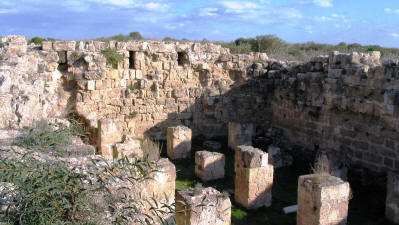The Byzantine Cistern (Vouta)
Salamis, Near Famagusta, North Cyprus
This cistern can be found at one end of the Agora, although dated at 400AD, it is much younger.
A city the size of Salamis obviously needed a large supply of water. Initially local sources could cope, but by Byzantine times, the city had to resolve the problem of not having enough water. Their answer? Bring it in from elsewhere.
 |
| The Byzantine Cistern |
The place chosen was Degirmenlik (Kythera), a village in the foothills of the Besparmak mountains, lying about 15 km north east of Nicosia. This village was built round a stream, flowing from a mountain stream which has never dried up in thousands of years.
A system of earthenware pipes and aqueducts were built to bring water the 30 miles to Salamis, to be stored in a large water tank. This is one of the largest stone cisterns in Cyprus. The walls and the remains of the 36 square pillars of the cistern have survived. the cistern was covered over, as can be seen by the massive supports projecting from its longer walls.
There is some discussion as to why a cistern was needed, when the supply from Digerminlik was so constant. The general feeling was simply that although the supply was constant, the delivery could not be guaranteed. The area suffered from earthquakes, which could easily destroy the pipes. In addition, the city did not totally control all of the land over which the pipe ran, so it was subject to political interference, as well as people from other villages en route simply diverting the water for their own use.
The cistern remained functional until the city was abandoned in the 7th century.
There is another Byzantine cistern, near the Roman Villa, where fragments of Christian paintings can be seen.
See the location in Google maps.
Return to Salamis Index, or Famagusta Index.